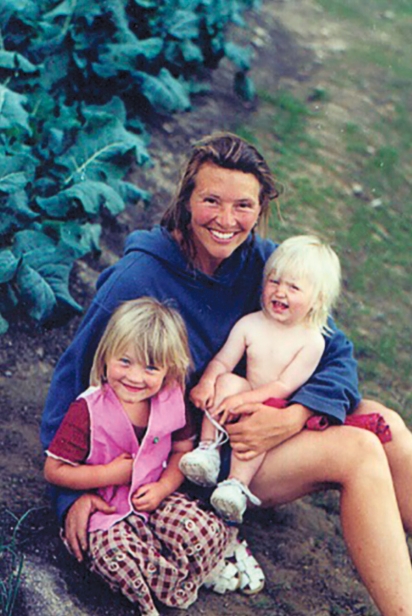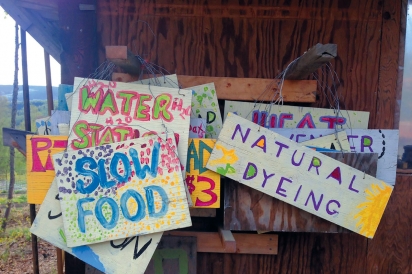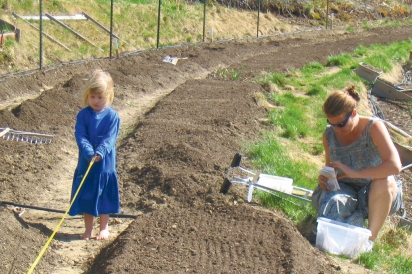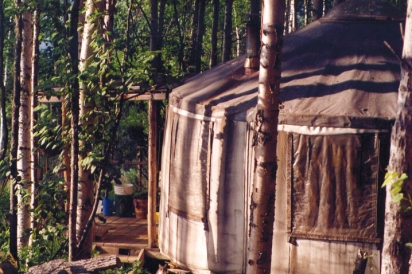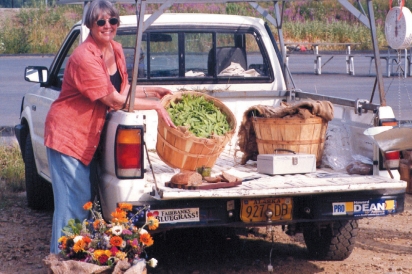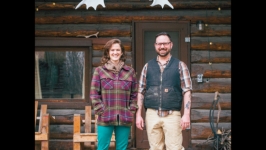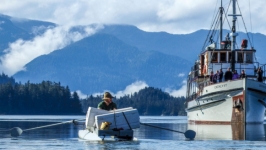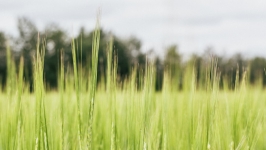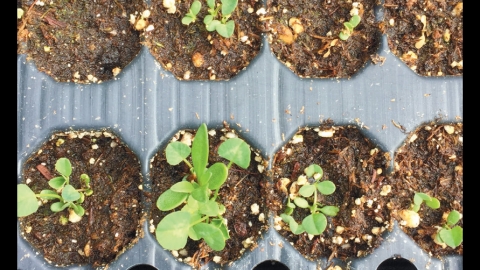Farm U - A Year with Calypso Farm & Ecology Center’s Farmer Training Program
(Part 1 of a 4-part series)
The thought often takes hold at the farmers market: what if, instead of making your weekly trip to buy fresh produce, you were there selling fresh rabbit meat or massive piles of greens or the tiniest bright red strawberries? Admit it. The thought has crossed your mind. There’s a dreamy escapist quality in the idea of running a small farm. A farm just big enough to feed your family, just big enough for that booth at the market, and to set up an honor system farm fresh egg stand on the side of the road. You dream of working with the land, the animals, of leaving behind cubicles or dress clothes—of very casual every day instead of somewhat casual Fridays. Of being your own boss. Of the ultimate work-at-home job.
But the leap from cubicle to cultivation, to keeping cows and pigs, to chasing chickens around (far beyond your trio of backyard chickens), and (here’s where real life gets in the way) running not just an environmentally sustainable, but also a fiscally sustainable farm? That leap can bury the dream under a ton of manure.
Many an aspiring farmer has dug into learning the howtos by working as an intern on an established farm or by traveling the world as a WWOOFer (WWOOF, which stands for “willing workers on organic farms,” lists member farms around the world that offer volunteers food, lodging, and a cultural experience in exchange for farm work). However, the education piece can be hit or miss, with some ending up more poorly paid (or unpaid) field hand than student. Instead, many farmers-to-be page through agricultural magazine ads and websites in search of mentorships, university programs, or on-farm education programs with curriculums that go far beyond “we’ll see how the day goes.”
In Alaska, there’s just one such on-farm program. Though still relatively new (it launched as a pilot program in 2012), the five-month Farmer Training Program at Calypso Farm and Ecology Center in Ester, Alaska, has started gaining a national reputation. And though potential students often first take a shine to the program because of the offbeat thrill of learning about farming in Alaska, they quickly learn that this is no novelty program.
The program at Calypso brings together traditional in-the-fields education with an extensive curriculum ranging from farm business plans to animal husbandry, blacksmithing, and seed saving. “The main thing I left there with was this confidence and inspiration and drive to go out and start farming on my own. And I did,” says Stephanie Stillman, a Minnesota resident who went through the program’s launch year.
The curriculum changes each year, thanks in part to extensive feedback from past participants. New this year, they’ve launched a Beginning Farmer Council which will check in with new farmers to see what they wish they had learned during the program.
The program costs $700 per month and includes some meals and lodging— the trainees live in cabins on the property. The course also offers a partnership and college credit through the University of Alaska Fairbanks.
Students don’t set foot on Calypso soil until May, but for the farm’s co-founders, Susan Willsrud and Tom Zimmer, things get going early in winter when the terraced field rests under deep snow. It’s quiet then, the summer buzz of working the soil, planting, growing, and harvesting ratcheted down to a quiet hum of planning, keeping the animals fed, and a few events here and there. Nothing like, as Willsrud describes it, “the controlled chaos” of summer when there are kids coming through on field trips; parents showing up with their toddlers to look at the animals; summer camps for kids; community classes for people who want to learn about spinning wool or blacksmithing or any of the other courses the couple, volunteers, and staffers offer on the grounds. And then there’s the farming itself, with produce growing at interior Alaska’s breakneck pace and requiring careful planning in order to harvest in rhythm with farmers markets and the farm’s CSA.
During the quiet of winter, emails from people who, in some cases, dream as much of the romance of Alaska as they do of farming, start to show up in Willsrud’s inbox. “The majority of [applicants and attendees] are from outside,” she says. The couple does no traditional advertising for the program. It’s mostly online through listservs and social media.
The 2017 class filled up quickly. All told, seven future farmers came to Ester this May. They include: a singer and education grad student from Brooklyn, an animal science graduate from Cal Poly who surfs and knits, and, in a rare turn, a local from North Pole, Alaska (most applicants are from the lower 48), who has six kids and dreams of starting her own farm within the next two to five years.
Andy Marion, 25, graduated from Keen College last fall. Working on farms “has always been a summer job,” says Marion, who went to school for environmental studies and was anxious to get back to farming. “I always wanted to go to Alaska. Once I saw the ad for [Calypso online] it was everything I was looking for, the full farm plan to spinning to construction to the science behind farm systems, “says Marion. “Everything I was looking for in a place I always wanted to go to.”
Willsrud and Zimmer started Calypso in 2000. “We were really looking to combine farm-based education and environmental education with a working farm,” says Willsrud. Both had experience in farming, but neither had come from a traditional farming back ground. Willsrud, who already had ties to the Fairbanks area, has a B.A. in botany and zoology, and an M.S. in plant ecology from the University of Alaska Fairbanks. Zimmer has an M.S. in soil science, and spent time farming in Africa while in the Peace Corps.
In the early days of the farm, Willsrud and Zimmer offered a traditional farm internship program. Over time they found that model discouraging. “People were not motivated to start their own farms. We had a lot of long-term interns,” says Willsrud. With a goal of growing the country’s community of farmers, they started asking the interns “what’s stopping you from starting your own farm?”
The interns weren’t worried about the planting or the animals. They had a good handle on the how-tos of all that, and understood that things often went sideways. But they were thrown by the business side of farming, the behind-the-scenes stuff. Where to start? What does it cost? What kind of insurance do you need for workers? How do you organize a CSA? Should I buy land? Lease it?
“It was so daunting. It is daunting,” says Willsrud.
Though Calypso is a 501(c)(3) non-profit, the feedback helped the couple realize that they needed to pay more attention to the “profitability of the farm operation. Really paying attention to the products and marketing, all the parts and pieces,” says Willsrud. “It’s really critical that we be an example of that.”
With farmer burnout a key reason why many new farms fail, they also found that they wanted to think more about the whole farm and the whole life of farmers. Though quality of life was not top of mind when Willsrud and Zimmer started Calypso, they felt it was important to guide students to make it a priority in their own farming lives.
“My true desire is to see more people join our community [of farming],” says Willsrud. “It’s really undervalued and romanticized at the same time, the profession. We want the next generation of farmers to be valued and respected as food producers and working members of the community.”
First the students have to face up to the reality of farming—leaving the romanticized version by the wayside. Willsrud says it doesn’t take long. By the end of the second week, those who spent more time in classrooms or cubicles before heading to Calypso are often eyes wide open about the incredible amount of physical work the program takes. There’s just four to six hours a week sitting around a table. The rest of the time, they’re learning carpentry and other skills by doing.
But even the hardest days are balanced out by the general goodwill of the staff and volunteers at Calypso. A necessity since the students live in cabins on the grounds and eat many meals together. “We’re not a super neat and tidy operation. There’s a lot of good-natured humor. People work hard and laugh a lot,” says Willsrud.
So, five years in, does Willsrud think the Farmer Training Program preps her students for the reality of farming? “I think people come out of it thinking, ‘if I’m going to take this on, it’s going to be a lot of work,’” says Willsrud. But most, she adds, aren’t deterred.
Join us over the next year of Edible Alaska issues as we get schooled on the Calypso way of becoming a farmer. In the next issue: spend time with Calypso’s class of 2017—and dig in as they settle onto the farm and get to work.
Calypso’s Farmer Education Training by the Numbers
Length of program: Five months
Cost of program: $700 per month
Beginning Farmer’s Bonus for those who complete the program: Refund of up to 50 percent of the program’s costs to put toward your future farm plan
Number of “Whole Farm Planning” lessons (think of it as a farm business plan): 20
Group discussions: Two per month
Farm visits to other area farms: Three or four
Number of dogs on Calypso Farm: Two, Tuva and Pelle (prepare to fall in love)



